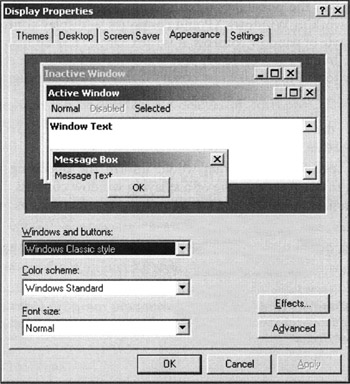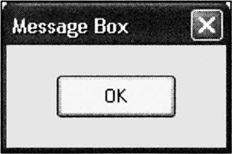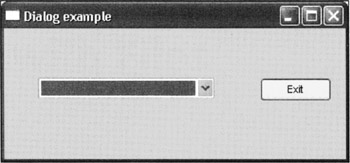Windows XP-Style Programming
| | ||
| | ||
| | ||
Windows XP-Style Programming
In the Windows XP operating system, as can be easily noticed, the window style and the design of controls have changed. Still, if desired, you can return to the classic Windows style by setting this property (Fig. 10.1).

Figure 10.1: Changing the style of windows and controls in Windows XP
It is necessary to distinguish window appearance and control style (Fig. 10.2).

Figure 10.2: Window and button styles
In contrast to window style, which is automatically formed by the operating system, the style of controls must be defined by the programmer. Because of this, all window controls of the programs written before the release of Windows XP have the old style. However, even if you program under Windows XP, the new style won't appear automatically if you are not using Delphi or C Builder. To achieve this goal, it is necessary to use an appropriate technology. This technology is the one that I'll describe now.
The USER32.DLL library was always responsible for displaying window controls. Consequently, you always include the INCLUDELIB USER32 .LIB directive into your programs to gain the possibility of controlling these window elements. This library continues to work in Windows XP and continues to display controls in the old style. For the new style of window controls, it is the COMCTL32.DLL library responsible for supporting it. In other words, to support window controls in the style of Windows XP, it is necessary to add the INLUDELIB COMCTL32 .LIB into your programs. This, however, is not sufficient. The following steps are also required:
-
Initialize the COMCTL32.DLL library using the initCommonControls or InitCommonControlsEx functions.
-
Create a special structure that would inform the operating system about your intention to use the new style of displaying window controls. This structure must be written in extensible markup language (XML). Its text is as follows :
<?xml version="1.0" encoding="UTF-8" standalone="yes"?> <assembly xmlns="urn:schemas-microsoft-com:asm.vl" manifestVersion="1.0"> <description>Windows XP program</description> <assemblyldentity version="1.0.0.0" processorArchitecture="X86" name="m.exe" type="win32" /> <dependency> <dependentAssembly> <assemblyldentity type="win32" name="Microsoft.Windows.Common-Controls" version="6.0.0.0" processorArchitecture="X86" publicKeyToken="6595b64144ccfldf" language="*" /> </dependentAssembly> </dependency> </assembly>
Pay special attention to the version=6.0.0.0 line. It informs the operating system that it is necessary to use the functions of COMCTL32.DLL library version 6.0. The name=m.exe string specifies the name of your program.
I think that you'll immediately ask: How is it possible to integrate this text into my programs? In fact, there are two ways of doing so:
-
If the text of your program is named, say, M.ASM, and the program, accordingly , is named M.EXE, then the XML code must be inserted into the file called M.EXE.MANIFEST. This file must be located in the same directory as the executable module M.EXE. This will be enough to display window controls in the new style. However, this is not always convenient , because the file with the manifest filename extension can be accidentally deleted or corrupted. Therefore, another, more reliable method is preferable.
-
XML text can be included in the resource file. This is achieved by inserting the following string into the beginning of the file " l 24 m.xml ". It is supposed that the XML code is located in the M.XML file. The resource compiler RC.EXE will compile this text into the object module; from there, it will be copied into the executable module.
At this point, I complete the theoretical considerations. You can start writing programs with elements in the Windows XP style right now (Listing 10.4 and Fig. 10.3).

Figure 10.3: Window created by the program in Listing 10.4
| |
// The M.RC file // Constant definitions // Window styles 1 24 "m.xml" #define WS_VSCROLL 200000h #define CBS_DROPDOWNLIST3h #define WS_OVERLAPPED Oh #define WS_CAPTION 0C00000h #define IDC_COMBOBOX1 101 #define WS_SYSMENU Ox00080000L #define WS_MINIMIZEBOX 0x00020000L #define WS_MAXIMIZEBOX 0x000l0000L // Style of all window elements #define WS_CHILD 0x40000000L // Window elements must // be initially visible #define WS_VISIBLE 0x10000000L // Using the <Tab> key, // it is possible to sequentially initialize // the button style #define BS_PUSHBUTTON 0x00000000L // Center the button text #define BS_CENTER 0x00000300L #define DS_LOCALEDIT 0x20L // Dialog definition DIAL1 DIALOG 0, 0, 240, 80 STYLE WS_OVERLAPPED WS_CAPTION WS_SYSMENU WS_MINIMIZEBOX WS_MAXIMIZEBOX CAPTION "Dialog example" FONT 8, "Arial" { CONTROL "Exit", 5, "button", BS_PUSHBUTTON BS_CENTER WS_CHILD WS_VISIBLE, 180, 30, 50, 14 CONTROL "ComboBox1", IDC_COMBOBOX1, "combobox", CBS_DROPDOWNLIST WS_CHILD WS_VISIBLE WS_VSCROLL, 24, 30, 124, 16 } .586P ; Flat memory model .MODEL FLAT, stdcall ; INCLUDELIB directives for linking libraries includelib d:\masm32\lib\comctl32.lib includelib d:\masm32\lib\user32.lib includelib d: \masm32\lib\kernel32.lib ; --------------------------------------- ; Constants ; The message arrives when the window is closed WM_CLOSE equ l0h WM_INITDIALOG equ 110h WM_COMMAND equ 111h ; Prototypes of external procedures EXTERN InitCommonControls@0:NEAR EXTERN UnregisterHotKey@8:NEAR EXTERN RegisterHotKey@16:NEAR EXTERN MessageBoxA@16:NEAR EXTERN ExitProcess@4:NEAR EXTERN GetModuleHandleA@4:NEAR EXTERN DialogBoxParamA@20:NEAR EXTERN EndDialog@8:NEAR EXTERN SendMessageA@16:NEAR EXTERN GetDlgItem@8:NEAR EXTERN MessageBoxA@16:NEAR ; Data segment _DATA SEGMENT HINST DD 0 ; Application descriptor PA DB "DIAL1", 0 STR1 DB "Invalid character!", 0 STR2 DB "Error!", 0 _DATA ENDS ; Code segment _TEXT SEGMENT START: CALL InitCommonControls@0 ; Get the application descriptor PUSH 0 CALL GetModuleHandleA@4 MOV [HINST], EAX ;------------------------- PUSH 0 PUSH OFFSET WNDPROC PUSH 0 PUSH OFFSET PA PUSH [HINST] CALL DialogBoxParamA@20 CMP EAX, -1 JNE KOL KOL: ;------------------- PUSH 0 CALL ExitProcess@4 ;------------------------------- ; Window procedure ; Position of parameters in the stack ; [EBP+014H] ; LPARAM ; [EBP+10H] ; WAPARAM ; [EBP+0CH] ; MES ; [EBP+8] ; HWND WNDPROC PROC PUSH EBP MOV EBP, ESP PUSH EBX PUSH ESI PUSH EDI ;----------------------------- CMP DWORD PTR [EBP+0CH], WM_CLOSE JNE LI PUSH 0 PUSH DWORD PTR [EBP+08H] CALL EndDialog@8 MOV EAX, 1 JMP FIN L1: CMP DWORD PTR [EBP+0CH], WM_INITDIALOG JNE L2 MOV EAX, 1 JMP FIN L2: CMP DWORD PTR [EBP+0CH], WM_COMMAND JNE FINISH ; Exit button? CMP WORD PTR [EBP+10H], 5 JNE FINISH PUSH 0 PUSH DWORD PTR [EBP+08H] CALL EndDialog@8 MOV EAX, 1 JMP FIN FINISH: MOV EAX, 0 FIN: POP EDI POP ESI POP EBX POP EBP RET 16 WNDPROC ENDP _TEXT ENDS END START | |
Because I only wanted to demonstrate the possibilities of using new styles of displaying elements, the program is elementary. The window contains only two elements: a button and a combobox. I'd like to emphasize again that window style has no relation to the theory. On the contrary, it is automatically formed by the operating system.
To assemble and link the program, issue the following commands:
ML /c /coff "m.asm" RC "m.rc" LINK /SUBSYSTEM:WINDOWS "m.obj" "m.res"
The use of TASM32 isn't considered here.
| | ||
| | ||
| | ||
EAN: 2147483647
Pages: 140